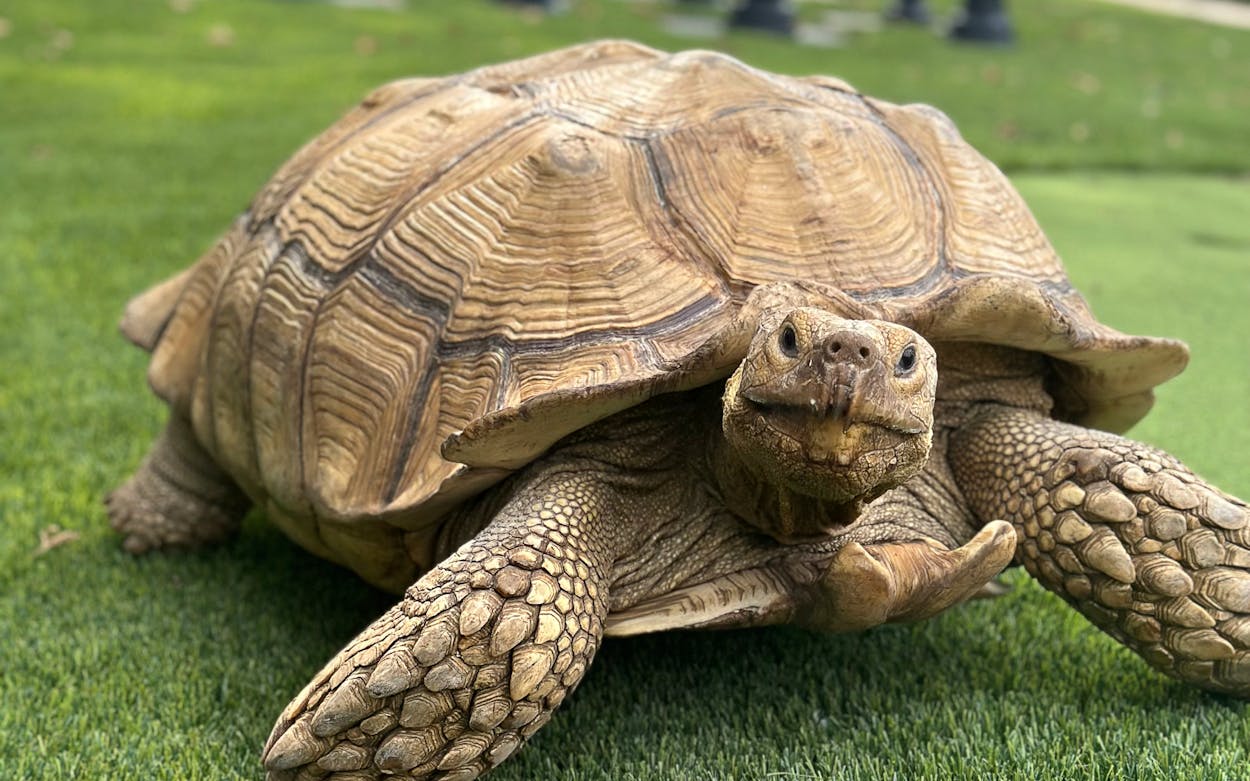In a sprawling 1.5-acre backyard populated by Silkie chickens, peacocks, dogs, tortoises, emus, and a spider monkey, you might think it’s easy to lose track of a critter here or there. But Gabriel Fernandez, an animal lover and landscaper who lives just southeast of Dallas, takes pride in carefully checking on his menagerie of more than forty pets every evening, so it wasn’t long before he noticed that something was amiss.
On the evening of August 29, Fernandez was making his rounds after work, feeding and watering the animals. But one of his three sulcata tortoises, Lorenzo, was nowhere to be found. Fernandez and his family scattered to search for the 27-year-old, 180-pound tortoise, but their efforts proved futile. As weeks passed, Fernandez, who’d owned Lorenzo for two years, became doubtful.
“I was afraid somebody was trying to keep him,” he said. “I was always worried that I wasn’t gonna be able to get him back.”
Then, after about three weeks of searching, his phone started buzzing. Around 8 p.m. on September 20, Fernandez started receiving an influx in messages. Friends and other contacts were sending him a Facebook post, from Dallas Animal Services, asking if anyone had lost a “very healthy, very large” sulcata tortoise that someone had brought into the shelter. The shelter staff had named it Wendell, but Fernandez immediately recognized Lorenzo. The next morning, he rushed to the downtown animal center, arriving thirty minutes before they opened. He stood as the first in line of other prospective adopters and tortoise owners.
But Fernandez had his evidence ready, with photos of Lorenzo’s signature spots and dents on the back of his shell. The similarities between Fernandez’s pictures and the tortoise in question were undeniable. After three weeks on the lam, Lorenzo is now back to munching on his favorite snack, zucchini, at home. (His life had been a colorful one even before the escape: Fernandez bought him from the Oklahoma zoo formerly owned by the infamous Joe Exotic.)
Tortoises go missing with surprising frequency. On September 27, another sulcata was found walking the streets of Texas City, near Galveston. Two years ago, former San Marcos mayor Daniel Guerrero reunited with his tortoise after 38 days apart. In June, a seven-year-old in Kansas found a tortoise that had been missing for nine months. Perhaps the most impressive reunion took place in Brazil in 2013, when a tortoise that had disappeared more than thirty years earlier was found hidden in an attic. On the Facebook post about Lorenzo, more than 250 people flooded the comment section, with dozens of them sharing their own wandering-tortoise tales or tagging friends who were looking for their own lost pets.
For Brenda Bush, assistant director at Pflugerville-based Central Texas Tortoise Rescue, this is business as usual. In the past twelve months, the nonprofit has rescued nearly 150 lost tortoises, Bush said. She attributes the phenomenon to multiple factors.
First, these “bulldozers” like to have their space. African sulcata tortoises are the third-largest tortoise species in the world. Yes, they’re slow, but not that slow: sulcatas typically move at around 0.3 miles per hour, or 26 feet per minute. And with their tenacious digging skills, they can easily burrow under or push over fences in search of more room to roam, which is why Central Texas Tortoise Rescue requires its adopters to have at least 6,000 square feet available outside.
Fernandez’s backyard is bigger than that, and he thought it was securely fenced in—but Lorenzo still dug his way out, leaving behind his siblings, Tank and Loretta.
“They’re really strong diggers,” Fernandez said. “If one stepped on your toe, you can feel they’re pretty heavy.” His advice to fellow tortoise owners: “Just make sure the fence line is good [and] secure.”
Bush agrees that good fencing is key. She suggests opting for sturdy wire material or hog paneling. But even then, tortoises just love to travel. “In the wild, they roam for miles,” Bush said. “For us to keep them in a small backyard or even a large area, they’re gonna want to wander because that’s what they do in nature.”
Bryan Johnson, a volunteer at Corpus Christi–based South Texas Tortoise Rescue, said that any fence a turtle can peek through may pose a problem: “If there are areas they can see through the fence, they’re going to spend their entire day trying to get out of it.”
All this should make you think twice about getting a tortoise of your own, and that’s before you consider their longevity. Sulcata tortoises kept as pets live about 54 years on average, though some will reach 80 or beyond. Other tortoise species endure even longer: Jonathan, a 190-year-old Seychelles giant tortoise, is the world’s oldest living land animal. “You probably see on Facebook when you’re looking through the turtle pages that a lot of senior citizens have T-shirts that say, ‘The only thing my kids are inheriting is my tortoise,’ ” Johnson said. “It’s a really long-term commitment.”
Fernandez and Lorenzo, thankfully, are now happily living out their long-term commitment. For now, at least, the tortoise seems content to graze alongside Loretta and Tank. He even occasionally lets Mowgli the spider monkey ride on his shell. “He’s back doing the same routine and doing his thing,” Fernandez said. “He just likes to eat grass. That’s all tortoises do. He just eats all day.”






